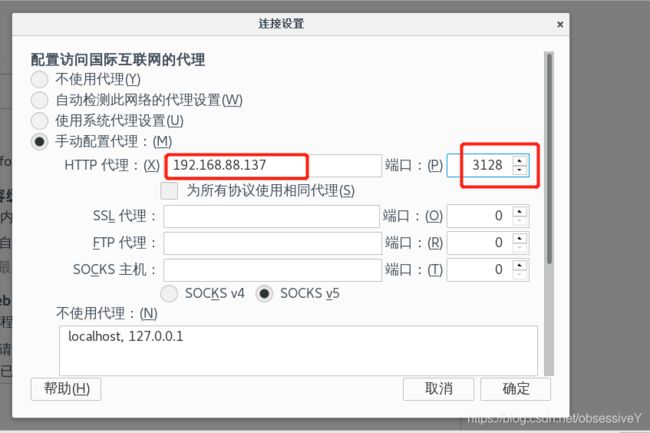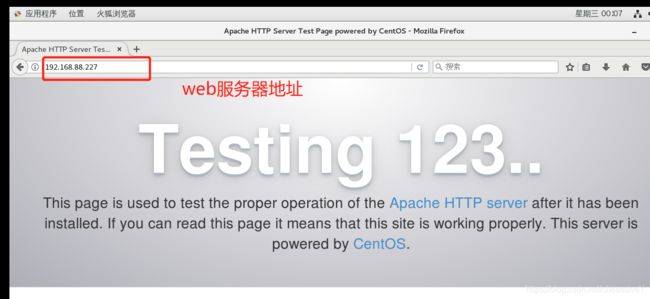Linux---squid传统模式
Linux—squid传统模式
一.什么是squid?
Squid是一个高性能的代理缓存internet数据的软件,Squid通过接受人们需要下载的目标(object)的请求并且适当地处理这些请求。即如果一个人想要下载一些web页面,他请求Squid为他取得这个页面。Squid随之连接到远程服务器,并向这个页面发出请求。然后,squid显式地聚集数据到客户端,而且同时复制一份,当下一次有人需要同一页面时,Squid可以简单地从磁盘中读到它,那样数据就会迅速的传输到客户机上。
二.代理的基本类型
1.传统代理:适用于Internet,需明确指定服务端
2.透明代理: 客户机不需要指定代理服务器的地址和端口,而是通过默认路由、防火墙策略将Web访问重定向给代理服务器处理
三.使用代理的好处
1.提高Web访问速度
2.隐藏客户机的真实IP地址
四.实验环境
一台squid服务器:192.168.88.137
一台web服务器:192.158.88.227
一台客户机
五.实验配置
1)配置squid服务器
1.准备squid包,解压到opt下
tar xzvf squid-3.4.6.tar.gz -C /opt
2.安装相关软件包
yum install gcc gcc-c++ make -y
3.编译安装
cd /opt/squid-3.4.6/
./configure \
--prefix=/usr/local/squid \
--sysconfdir=/etc \
--enable-arp-acl \
--enable-linux-netfilter \
--enable-linux-tproxy \
--enable-async-io=100 \
--enable-err-language="Simplify_Chinese" \
--enable-underscore \
--enable-poll \
--enable-gnuregex
make && make install
4.创建链接文件,优化路径
ln -s /usr/local/squid/sbin/* /usr/local/sbin
5.创建程序用户、组
useradd -M -s /sbin/nologin squid
6.改变目录属主
chown -R squid:squid /usr/local/squid/var/
7.修改squid配置文件
vim /etc/squid.conf
55 # And finally deny all other access to this proxy
56 http_access allow all //允许所有用户
57 #http_access deny all
58
59 # Squid normally listens to port 3128
60 http_port 3128
61 cache_mem 64 MB //缓存使用内存大小
62 reply_body_max_size 10 MB //允许下载最大文件大小
63 maximum_object_size 4096 KB //允许缓存最大大小
64 cache_effective_user squid //指定用户
65 cache_effective_group squid //指定组
8.设置防火墙
清空规则
iptables -F
iptables -t nat -F
添加规则
iptables -I INPUT -p tcp --dport 3128 -j ACCEPT
9.检查语法
squid -k parse
10.初始化缓存
squid -z
11.启动服务
[root@localhost squid-3.4.6]# squid
[root@localhost squid-3.4.6]# netstat -natp | grep squid
tcp6 0 0 :::3128 :::* LISTEN 73824/(squid-1)
12.编写脚本,优化service控制方式
[root@localhost ~]# vi /etc/init.d/squid
#!/bin/bash
#chkconfig: 2345 90 25
PID="/usr/local/squid/var/run/squid.pid"
CONF="/etc/squid.conf"
CMD="/usr/local/squid/sbin/squid"
case "$1" in
start)
netstat -utpln | grep squid &>/dev/null
if [ $? -eq 0 ]
then
echo "Squid is running"
else
$CMD
fi
;;
stop)
$CMD -k kill &>/dev/null
rm -rf $PID &>/dev/null
;;
status)
[ -f $PID ] &>/dev/null
if [ $? -eq 0 ]
then
netstat -utpln | grep squid
else
echo "Squid is not running"
fi
;;
restart)
$0 stop &>/dev/null
echo "正在关闭Squid..."
$0 start &>/dev/null
echo "正在启动Squid..."
;;
reload)
$CMD -k reconfigure
;;
check)
$CMD -k parse
;;
*)
echo "用法:{start | stop | restart | reload | check | status}"
esac
13.添加执行权限
chmod +x /etc/init.d/squid
14.添加service服务
chkconfig --add squid
15.开机自启
chkconfig --level 35 squid on
16.重启服务
[root@localhost squid-3.4.6]# service squid restart
正在关闭Squid...
正在启动Squid...
2)配置web服务器
yum install httpd -y
systemctl stop firewalld.service
setenforce 0
systemctl start httpd.service
netstat -natp | grep 80



